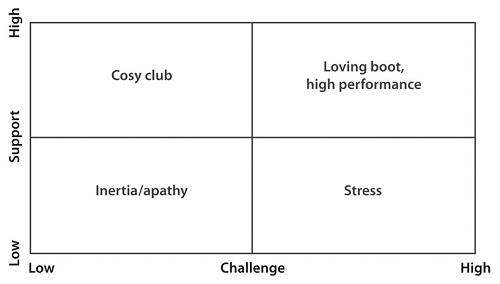Ian Day and John Blakey continue their series on challenging leadership. This time the focus is on delegation.
In these tough economic times leaders need to adopt an approach that both supports individuals yet also challenges them to step up. Last month we introduced the concept of challenging leadership suggesting that a high support / high challenge approach is appropriate to motivating and engaging a modern workforce. We referred to this style as the ‘loving boot’. In this article we will focus on how to use the ‘loving boot’ to achieve effective delegation.

In the example dialogue that follows you will notice several ‘loving boot’ techniques being used:-
- A courageous goal being used to motivate and engage
- Precise contracting to ensure that two-way expectations and accountabilities
- The necessity of creating an environment in which staff have permission to challenge and speak openly
- The role of feedback in providing motivation and a clear grasp of reality
- The use of systems thinking to explore knock-on effects and engage relevant stakeholders
Leader: “Jane, I would like you to do this piece of work. We need to research the oil market and make an investment recommendation for the Board meeting next Friday. Can you do this?”
The leader challenges Jane to commit to a courageous goal and initiates a process of contracting.
Jane: “I’ve never done a board report before, this sounds like a bit of a stretch.”
The leader has created a trusting relationship in which the report can speak openly.
Leader: “I know you are the best person for the job, you have the greatest knowledge of the oil market and the analysis report you produced last month for me was excellent. We can have regular meetings to review how you are progressing.”
The leader provides positive feedback to show belief in Jane and offers to support her in the task.
Jane: “Okay, but let me clarify a few things first. When you say the oil market do you mean current consumption levels across the globe along with forecasts?”
Jane accepts the challenge and offer of support and seeks to clarify the expectations.
Leader: “Yes, current usage, with forecast.”
Jane: “Okay, what format do you want the report to be in?”
Leader: “Here is a copy of my last board paper which you can use as a template”
The process of contracting continues to establish clear expectations.
Jane: “And to help me put this in to context, how will the board use this information, and what do you see happening following the meeting?”
Jane seeks to understand the ‘bigger picture’ purpose of the task.
Leader: “Good question, the board is looking at the long term investment portfolio and Hendersons, the external advisors, have proposed oil as a growth market, but I want to check it out independently so the board has a balanced view.”
Jane: “That’s helpful, I’m clear. But I have to say this will take up all of my time, and so I won’t be able to work on the zoning project.”
Jane highlights the knock-on consequences of her commitment to the task.
Leader: “I understand. The board report is higher priority so the zoning project can be pushed back a few days, and I’ll talk to Dave about this. OK, let’s agree a 30 minute review meeting on Tuesday afternoon and again on Thursday morning.”
The leader seeks to build in checkpoints at which progress can be reviewed.
By being in the high support/ high challenge quadrant the leader avoids the risks of the ‘cosy club’ where excessive support and little challenge keeps the member of staff firmly in their comfort zone with weak accountability for future deliverables. Equally, by avoiding the high challenge / low support stress zone, the leader ensures that the individual is not overwhelmed, losing their resourcefulness and left looking for excuses to avoid completing the task.
We can see from the above example that the ‘loving boot’ represents an adult-adult conversation where the leader’s prime responsibility is to create an environment where staff can speak their truth openly. Responsibility has been fully delegated (the challenge) yet there is a commitment to provide advice and expertise (the support). Both the leader and the direct report can leave the conversation with clarity as to their own precise role and with confidence that the goal will be achieved. Next month – performance management using the loving boot.
Ian and John's book 'Challenging Coaching– Going beyond traditional coaching to face the FACTS' published by Nicholas Brealey Publishing is available on Amazon. More resources, including a free chapter download can be accessed via www.challengingcoaching.co.uk. This is the second of a monthly column on TrainingZone to explore the detail of challenging leadership.
Ian Day and John Blakey continue their series on challenging leadership. This time the focus is on delegation.
In these tough economic times leaders need to adopt an approach that both supports individuals yet also challenges them to step up. Last month we introduced the concept of challenging leadership suggesting that a high support / high challenge approach is appropriate to motivating and engaging a modern workforce. We referred to this style as the ‘loving boot’. In this article we will focus on how to use the ‘loving boot’ to achieve effective delegation.

In the example dialogue that follows you will notice several ‘loving boot’ techniques being used:-
- A courageous goal being used to motivate and engage
- Precise contracting to ensure that two-way expectations and accountabilities
- The necessity of creating an environment in which staff have permission to challenge and speak openly
- The role of feedback in providing motivation and a clear grasp of reality
- The use of systems thinking to explore knock-on effects and engage relevant stakeholders
Leader: “Jane, I would like you to do this piece of work. We need to research the oil market and make an investment recommendation for the Board meeting next Friday. Can you do this?”
The leader challenges Jane to commit to a courageous goal and initiates a process of contracting.
Jane: “I’ve never done a board report before, this sounds like a bit of a stretch.”
The leader has created a trusting relationship in which the report can speak openly.
Leader: “I know you are the best person for the job, you have the greatest knowledge of the oil market and the analysis report you produced last month for me was excellent. We can have regular meetings to review how you are progressing.”
The leader provides positive feedback to show belief in Jane and offers to support her in the task.
Jane: “Okay, but let me clarify a few things first. When you say the oil market do you mean current consumption levels across the globe along with forecasts?”
Jane accepts the challenge and offer of support and seeks to clarify the expectations.
Leader: “Yes, current usage, with forecast.”
Jane: “Okay, what format do you want the report to be in?”
Leader: “Here is a copy of my last board paper which you can use as a template”
The process of contracting continues to establish clear expectations.
Jane: “And to help me put this in to context, how will the board use this information, and what do you see happening following the meeting?”
Jane seeks to understand the ‘bigger picture’ purpose of the task.
Leader: “Good question, the board is looking at the long term investment portfolio and Hendersons, the external advisors, have proposed oil as a growth market, but I want to check it out independently so the board has a balanced view.”
Jane: “That’s helpful, I’m clear. But I have to say this will take up all of my time, and so I won’t be able to work on the zoning project.”
Jane highlights the knock-on consequences of her commitment to the task.
Leader: “I understand. The board report is higher priority so the zoning project can be pushed back a few days, and I’ll talk to Dave about this. OK, let’s agree a 30 minute review meeting on Tuesday afternoon and again on Thursday morning.”
The leader seeks to build in checkpoints at which progress can be reviewed.
By being in the high support/ high challenge quadrant the leader avoids the risks of the ‘cosy club’ where excessive support and little challenge keeps the member of staff firmly in their comfort zone with weak accountability for future deliverables. Equally, by avoiding the high challenge / low support stress zone, the leader ensures that the individual is not overwhelmed, losing their resourcefulness and left looking for excuses to avoid completing the task.
We can see from the above example that the ‘loving boot’ represents an adult-adult conversation where the leader’s prime responsibility is to create an environment where staff can speak their truth openly. Responsibility has been fully delegated (the challenge) yet there is a commitment to provide advice and expertise (the support). Both the leader and the direct report can leave the conversation with clarity as to their own precise role and with confidence that the goal will be achieved. Next month – performance management using the loving boot.
Ian and John's book 'Challenging Coaching– Going beyond traditional coaching to face the FACTS' published by Nicholas Brealey Publishing is available on Amazon. More resources, including a free chapter download can be accessed via www.challengingcoaching.co.uk. This is the second of a monthly column on TrainingZone to explore the detail of challenging leadership.







